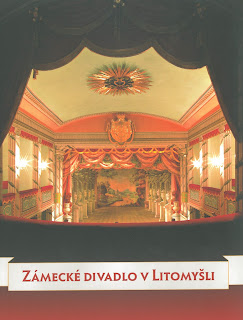Visit on 21th of June 2015 with the OISTAT Theatre Timeline Group
Litomyšl Palace, a UNESCO World Heritage, was built in 1567–1581. Two successive palace theatres operated in the 18th century before the still existing one was inaugurated in 1798.
This charming theater is is hidden behind an ordinary door on the courtyard of the palace.
According to the guide, the stage was used as bicycle garage for the personal until 2 years ago.
At the moment it looks very well preserved, with 2 copied sets in place.
The original sets are in storage, but they hope to have an exhibition in 2 years.
 |
| View from the first row (photo by Hanneke van de Kerkhof) |
Are these holes the places where the oil lamps used to be?
 |
| Footlights (photo by Hanneke van de Kerkhof) |
This is a typical mechanized flat wing theatre with six wings and some backdrops.
 |
| view in the wings cour (photo by Hanneke van de Kerkhof) |
This means that lifts etc. are not possible, and that there is not much room under the stage.
Wing changes had to bed one from the corridor next the stage (according to the guide, we never saw it)
 |
| The main drum under the stage (Photo Jiri Blaha) |
 |
| Borders view from the audience (photo by Hanneke van de Kerkhof) |
 |
| (photo by Hanneke van de Kerkhof) |
 |
| (photo by Hanneke van de Kerkhof) |
It is my guess that the borders from one scene would be connected to one pole and the ones of the other scene to the other one.
The drum where both behind the backdrops, so the two machinists, standing under the drums, holding the operating rope, could see each other behind the backdrop.
That way they could coordinate the movement of the wings of the two sets.
It is often thought all the parts of one set would go out at the same time as the the parts of the other set go in.
This system creates a sort of "limbo" in the scene change, as there is a moment the visible set goes out, but the next one is not visible yet.
With this system it's possible to lower one set of wings in front or behind the existing one, before it goes out, thus preserving the size of the stage.
 |
| View from the stage (Photo Hanneke van de Kerkhof) |
Altough it's only in Czech, it's worth to buy for the beautiful drawings and photo's in it, like this one:


No comments:
Post a Comment